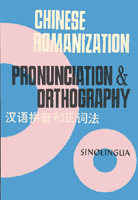 Today’s release from Yin Binyong’s Chinese Romanization: Pronunciation and Orthography is a long, important section that covers verbs in Hanyu Pinyin (2 MB PDF).
Today’s release from Yin Binyong’s Chinese Romanization: Pronunciation and Orthography is a long, important section that covers verbs in Hanyu Pinyin (2 MB PDF).
In this post I’ll go over the rules for what to do with Mandarin’s three tense-marking particles — zhe (著/着), guo ( 過/过), and le (了) — since these participles are extremely common and people are often unaware of how they should be written in Pinyin. Fortunately, this is pretty easy: -zhe and -guo are always written solid (with no interposing space or hyphen) with the verb they follow. The case of le is more complicated (but not too much trouble).
-zhe 著/着
-zhe is added onto a verb to indicate the ongoing nature of an action or state, whether in the past, present, or future. It thus bears a certain similarity to the English verb suffix -ing. A sentence in which -zhe is used tends to emphasize the description of the action or state indicated by the verb. Since no other sentence component may be interposed between a verb and -zhe, a general rule may be stated: -zhe is always written as one unit with the verb it follows.
Some examples:
Tā wēixiàozhe duì wǒ shuō: “Nǐ lái ba!”
她微笑著對我說: “你來吧!”
(Smiling, she said to me, “Come on!”)Nǐ xiān děngzhe, ràng wǒ jìnqu kànkan.
你先等著,讓我進去看看.
(You wait out here while I go in and look.)
Note that “kànkan” in the sentence above shows something else about verbs in Hanyu Pinyin: the second part of a reduplicated verb is in the neutral tone.
-guo 過/过
-guo is added after a verb to indicate that a given person or object has experienced the action expressed by the verb. -guo may only be used in the past tense. Since no other sentence component may be interposed between a verb and -guo, a general rule may be formulated: -guo is always written as one unit with the verb it follows.
Some examples:
Wǒ xuéguo liǎng nián Yīngyǔ, dànshì méi xuéguo Rìyǔ.
我學過兩年英語,但是沒學過日語.
(I’ve studied two years of English, but I haven’t studied Japanese.)Nà běn shū wǒ kànjianguo, hǎoxiàng zài shūjià shang.
那本書我看見過,好像在書架上.
(I have seen that book somewhere; I think it’s on the bookshelf.)
le 了
The tense-marking particle le is added after a verb to emphasize that the action expressed has been completed or that the state indicated has been achieved. -le is ordinarily written as one unit with the verb it follows.
For example:
Zuótiān wǎnshang wǒ kànle yī chǎng diànyǐng.
昨天晚上我看了一場電影.
(I saw a movie yesterday evening.)
But here’s where it starts to get a little more complicated.
If a verb complement is interposed between the verb and the tense marker -le in a sentence, there are two possible written forms. If the verb and its complement are written as a unit, then –le is written as a unit with them; if they are written separately, then -le too is written separately.
For example:
Xiǎo Chén qīngqīng de guānshangle fángmén.
小陳輕輕的關上了房門.
(Xiao Chen gently closed the house door.)
But also:
Tā cóng shūbāo lǐ ná chūlai le liǎng běn liánhuánhuà.
他從書包裡拿出來了兩本連環畫.
(He pulled two comic books out of his bookbag.)
(ná 拿 — verb; chūlai 出來 — complement)
I suspect that’s the sort of thing that may well change (for the simpler) once Pinyin makes it out into the world of popular usage as a script in its own right. But for now I’m just givin’ the rules as I find ‘em.
Speaking of which, here’s the final twist on -le.
Apart from its function as a tense-marking particle, -le can also serve as a mood-marking particle. (The former usage is usually denominated le1 and the latter le2 in grammar texts.) In its latter capacity, le always appears at the end of a sentence or clause, just before a comma, period, or other punctuation mark. The two different le’s, le1 and le2, are sometimes quite difficult to distinguish in practice. With this in mind, and with the aim of simplifying HP orthography, the, following simple rule is set out: any le, whether le1 or le2, appearing at the end of a sentence or clause is to be written by itself.
Thus, that’s actually a good thing, since it simplified matters. So, for anyone programming a Pinyin converter, put a space before le if it is immediately followed by punctuation.
Thus, for example:
Wǒmen túshūguǎn yǐjing mǎile sānwàn duō běn shū le.
我們圖書館已經買了三萬多本書了.
(Our library has already purchased over thirty thousand books.)Hǎo le, hǎo le, dàjiā dōu bié chǎo le.
好了好了, 大家都別吵了.
(All right, all right, everybody quiet down.)
Remember: This post covered only one small aspect of the entire reading. So be sure to download and read the entire PDF, which has many, many more examples.
It’s also a very useful reading for students of Mandarin.

Nice to have you back!
Pingback: Links 29 March 2009 - David on Formosa
Pingback: Pinyin news » How to write adverbs in Hanyu Pinyin
Pingback: Pinyin news » le redux
Pingback: Pinyin news » Spreading the good news
Pingback: Pinyin news » How to write verbs in Hanyu Pinyin (Mandarin text)